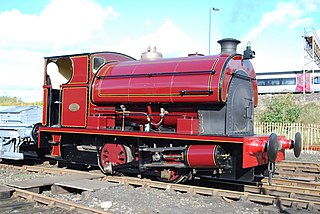Related Research Articles
The Bolton and Leigh Railway (B&LR) was the first public railway in Lancashire, it opened for goods on 1 August 1828 preceding the Liverpool and Manchester Railway (L&MR) by two years. Passengers were carried from 1831. The railway operated independently until 1845 when it became part of the Grand Junction Railway.

Ruston & Hornsby was an industrial equipment manufacturer in Lincoln, England founded in 1918. The company is best known as a manufacturer of narrow and standard gauge diesel locomotives and also of steam shovels. Other products included cars, steam locomotives and a range of internal combustion engines, and later gas turbines. It is now a subsidiary of Siemens.

Sentinel Waggon Works Ltd was a British company based in Shrewsbury, Shropshire that made steam-powered lorries, railway locomotives, and later, diesel engined lorries, buses and locomotives.

Benjamin Hick was an English civil and mechanical engineer, art collector and patron; his improvements to the steam engine and invention of scientific tools were held in high esteem by the engineering profession, some of Hick's improvements became public property without claiming the patent rights he was entitled to.

Horwich Works was a railway works built in 1886 by the Lancashire and Yorkshire Railway (LYR) in Horwich, near Bolton, in North West England when the company moved from its original works at Miles Platting, Manchester.
Kitson and Company was a locomotive manufacturer based in Hunslet, Leeds, West Yorkshire, England.
R and W Hawthorn Ltd was a locomotive manufacturer in Newcastle upon Tyne, England, from 1817 until 1885.
B. Hick and Sons, subsequently Hick, Hargreaves & Co, was a British engineering company based at the Soho Ironworks in Bolton, England. Benjamin Hick, a partner in Rothwell, Hick and Rothwell, later Rothwell, Hick & Co., set up the company in partnership with two of his sons, John (1815–1894) and Benjamin (1818–1845) in 1833.

Sharp, Stewart and Company was a steam locomotive manufacturer, initially located in Manchester, England. The company was formed in 1843 upon the demise of Sharp, Roberts & Co.. It moved to Glasgow, Scotland, in 1888, eventually amalgamating with two other Glaswegian locomotive manufacturers to form the North British Locomotive Company.

Rothwell, Hick and Rothwell was an engineering company in Bolton, England. Set up in 1822, the partners became interested in the production of steam locomotives after the Rainhill Trials. The company's first engine was Union, a vertical boiler, 2-2-0 with horizontal cylinders for the Bolton and Leigh Railway of which Hick and Rothwell were promoters and original shareholders, followed by three more locomotives the following year for American railways.

Peckett and Sons was a locomotive manufacturer at the Atlas Locomotive Works on Deep Pit Road between Fishponds and St. George, Bristol, England.
Day, Summers and Company was a British steam locomotive manufacturer and shipbuilder in the Southampton area. The company's history is complex and involves five men: William Alltoft Summers, John Thomas Groves, Charles Arthur Day, William Baldock and Nathaniel Ogle.

John Hick was a wealthy English industrialist, art collector and Conservative Party politician who sat in the House of Commons from 1868 to 1880, he is associated with the improvement of steam-engines for cotton mills and the work of his firm Hick, Hargreaves and Co. universal in countries where fibre was spun or fabrics woven.

The South African Railways Class 10D 4-6-2 of 1910 was a steam locomotive from the pre-Union era in Transvaal.
Chequerbent railway station was a railway station in Westhoughton to the south-west of Bolton, Greater Manchester, on the line between Bolton and Leigh. It was open from 1831 until its replacement in 1885 by a later station.

The South African Railways Class 4 4-8-2 of 1911 was a steam locomotive from the pre-Union era in the Cape of Good Hope.
Thomas Smith & Sons manufactured steam, diesel and electric powered cranes in their Old Foundry on a narrow strip of land between Town Street in Rodley near Leeds and the Leeds and Liverpool Canal.
London, Midland and Scottish Railway(LMS) Sentinel No. 7164, was a small shunting locomotive. Its design was that of the single-speed Sentinel, a vertical-boilered geared locomotive, using Sentinel's standard vertical boiler and steam motor design. This was the smallest of the four Sentinel classes used by the LMS.

Dewrance & Co. Ltd was a manufacturer of engine and boiler accessories, such as pumps and gauges.
References
- Lowe, J.W., (1989) British Steam Locomotive Builders, Guild Publishing